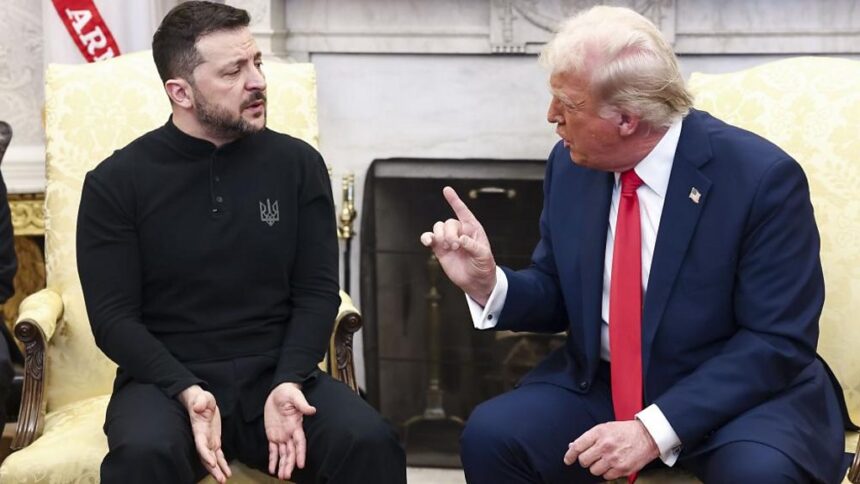In a dramatic and confrontational exchange at the White House, U.S. President Donald Trump clashed with Ukrainian President Volodymyr Zelensky, accusing him of “gambling with World War Three” and pressuring him to negotiate a peace deal with Russia. The tense meeting, originally planned to solidify a minerals trade agreement, quickly unraveled as the two leaders engaged in an open dispute over the ongoing war in Ukraine.
A Fractured Dialogue

What was supposed to be a diplomatic engagement quickly turned hostile when Trump, alongside Vice President JD Vance, insisted that Ukraine must seek a compromise with Russian President Vladimir Putin to end the war. Trump made it clear that U.S. support could not be unconditional, warning Zelensky, “Make a deal with Russia, or we are out.”
Zelensky pushed back, arguing that any compromise would embolden Putin and undermine Ukraine’s sovereignty. “There should be no compromises with a dictator,” he said, referencing Russia’s full-scale invasion of Ukraine in 2022 and its ongoing occupation of about 20% of Ukrainian territory.
At one point, tensions escalated when Vice President Vance accused Zelensky of being “disrespectful” by challenging U.S. recommendations in front of the media. Trump joined in, criticizing Zelensky for what he described as ingratitude toward Washington’s military and financial assistance.
Trump’s Hardline Stance on Ukraine
The meeting was supposed to conclude with the signing of a minerals deal, which would grant the U.S. increased access to Ukraine’s oil, gas, and rare minerals. However, the fallout led to the meeting’s abrupt end, with Zelensky leaving the White House ahead of schedule.
Following the meeting, Trump took to his social media platform, Truth Social, to express his frustration. “Zelensky disrespected the U.S. in its cherished Oval Office,” he wrote. “I have determined that President Zelensky is not ready for peace if America is involved because he feels our involvement gives him a big advantage in negotiations. I don’t want advantage, I want PEACE.”
Zelensky later responded in a Fox News interview, acknowledging the confrontation but maintaining that the relationship between Ukraine and the U.S. could be repaired. “Because the relations are more than just two presidents,” he said, “it’s about the strong ties between our people.”
Political Fallout in Washington and Beyond
The public dispute immediately triggered strong reactions from both political parties in the U.S.
- Republican Reactions: Many Republican lawmakers defended Trump’s position, arguing that U.S. aid to Ukraine should come with conditions. Senator Lindsey Graham, who had previously been a staunch supporter of Ukraine, remarked: “What I saw in the Oval Office was disrespectful. I don’t know if we can ever do business with Zelensky again. He either needs to resign or send someone we can work with.”
- Democratic Reactions: On the other hand, Democrats condemned Trump’s handling of the meeting. House Minority Leader Hakeem Jeffries called Zelensky’s treatment “appalling” and warned that it would “only embolden Vladimir Putin.”
European Leaders Express Concern
The fallout from the Trump-Zelensky dispute is already rippling through Europe.
- UK Prime Minister Sir Keir Starmer reportedly spoke to both leaders and reaffirmed Britain’s “unwavering support for Ukraine.”
- German opposition leader Friedrich Merz tweeted, “We must never confuse aggressor and victim in this terrible war. Ukraine deserves our full support.”
- EU Foreign Policy Chief Kaja Kallas stated, “Today, it became clear that the free world needs a new leader. It’s up to us, Europeans, to take this challenge.”
Russia Responds
The Kremlin wasted no time reacting to the dispute. A Russian foreign ministry spokesperson described Trump’s stance as “a sign of realism,” while also noting that it was “a miracle the Americans didn’t physically remove Zelensky from the room.”
Meanwhile, Russian state media portrayed the White House incident as evidence of waning Western support for Ukraine, a narrative that could strengthen Moscow’s position in ongoing conflicts.
What’s Next for U.S.-Ukraine Relations?
The confrontation between Trump and Zelensky signals a potential shift in U.S. policy toward Ukraine, raising concerns about whether the U.S. will continue to provide military and financial support. If Trump’s administration follows through on its hardline stance, Europe may be forced to take a more prominent role in supporting Ukraine.
While Zelensky maintains that Ukraine will not concede to Russian aggression, his country now faces a more uncertain geopolitical landscape. With elections looming in multiple Western nations, including the U.S., the future of Ukraine’s alliances remains unpredictable.
As the dust settles from this high-stakes meeting, the world watches closely to see how Ukraine navigates its next steps—whether through diplomacy, continued resistance, or shifting alliances.
Conclusion
The Trump-Zelensky clash highlights deep divisions in international policy on Ukraine, with far-reaching implications for NATO, Europe, and global security. If Trump holds firm on his demand for peace talks with Russia, Ukraine may find itself increasingly isolated. Meanwhile, European leaders now face the challenge of stepping up their support, as the prospect of a U.S. pullback looms.
As tensions persist, the question remains: will the West stand united in its support for Ukraine, or will cracks in the alliance give Russia the upper hand?









